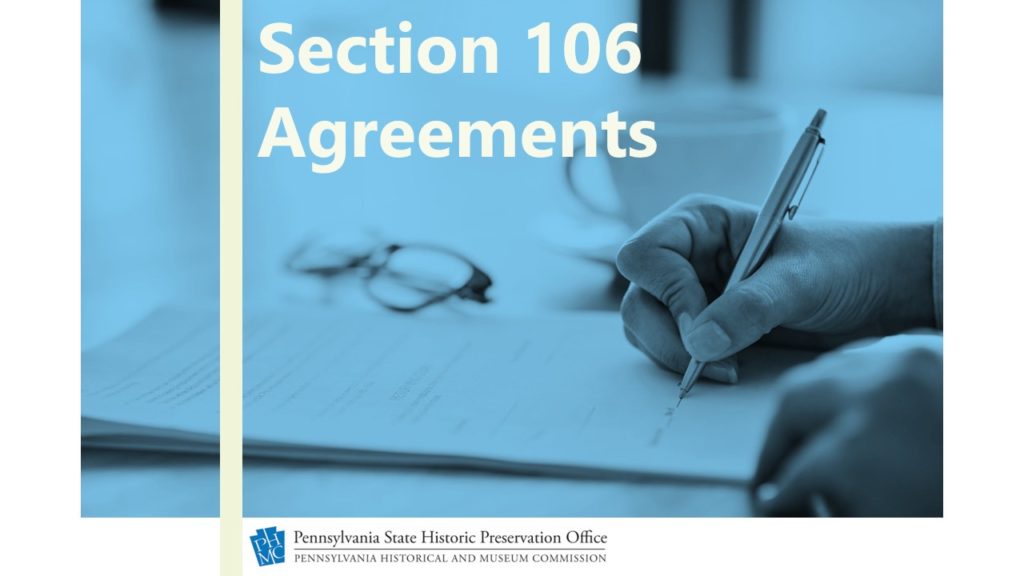This is part of a biannual blog series highlighting the agreement documents executed by PA SHPO in accordance with Section 106 of the National Historic Preservation Act and its implementing regulations.
Between January 1 and June 30, 2023, PA SHPO has been a signatory to approximately nine (9) Section 106 agreement documents with six different federal agencies as part of consultation for the resolution of adverse effects to historic properties.
Below illustrates a selection of the agreement documents executed within the past six months.
Programmatic Agreement between the U.S. Department of Housing and Urban Development, Advisory Council on Historic Preservation, and PA SHPO for the Review of HUD-Assisted Projects and Programs Subject to 24 CFR Part 50 and Part 58, Commonwealth of Pennsylvania.
This statewide Programmatic Agreement (PA) applies to Section 106 review of projects in Pennsylvania that are subject to Part 50 and 58 of HUD’s environmental regulations. This PA covers review of HUD-assisted projects in Multifamily Housing, Healthcare, CDBG, Disaster Recovery, HOME, Public Housing, among others.
The purpose of the PA is to improve efficiency of Section 106 review of HUD projects by all agencies involved while fostering the protection and consideration of historic properties in project planning. The PA exempts from Section 106 review a list of types of activities that do not have the potential to cause effects to historic properties, like refinancing of existing buildings, replacement of heating systems, bathroom and kitchen remodeling, and repairs of roofs and windows.
The streamlined process outlined in the PA applies to HUD offices and Responsible Entities (REs are units of state and general local governments) that conduct Section 106 review of HUD projects and that have signed the PA as Signatory Parties. This PA will remain in effect for the next ten years.
To date, approximately nine REs, including the City of Pittsburgh, have signed the PA, and PA SHPO is encouraging others to do so. Please reach out to Emma Diehl, emdiehl@pa.gov, if interested in learning more.
Letter of Agreement between the Federal Highway Administration, the Pennsylvania Department of Transportation, and PA SHPO regarding the West Shore Bypass Reconstruction Project, Berks County.
The proposed project includes widening S.R. 422 to facilitate additional travel lanes, wider shoulders, and median, and additional interchange and structure improvements along an approximately five-mile corridor in order to address safety and congestion issues. As a result of consultation, the proposed project was determined to have an adverse effect on the Buttonwood Street and Bingaman Street bridges, both of which are eligible for listing in the National Register of Historic Places.
The 1931 Buttonwood Bridge is historically and technologically significant as one of 12 open spandrel concrete arch bridges built in Berks County between 1913 and 1955. At 460’, the bridge has the greatest clear span length for a reinforced concrete arch in the entire country.
Bingaman Street Bridge, constructed in 1920-1921, was determined eligible as part of the concrete arch bridge reevaluation in 2019 as a significant example of a multiple span open spandrel arch bridge with exceptional overall length featuring outstanding ornamentation and artistic value.
Mitigation developed to resolve the adverse effects to these historic properties include designing a Spanish/English bilingual driving tour and map of open-spandrel concrete arch bridges in Reading, which will be available on PennDOT’s Cultural Resources Section website, with links made available for posting to local organizations’ websites. In addition, corresponding information panels about each stop will be installed in the vicinity of each bridge. The contents and exact location of information at each bridge will be determined through ongoing consultation with PA SHPO and other consulting parties.
Remember – Section 106 is inherently a consultative law, and that consultation is most effective when other consulting parties get involved. Learn more about Section 106 and consulting parties here!
